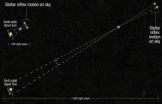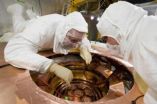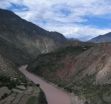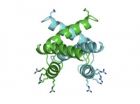(Press-News.org) Outdoor enthusiasts in Colorado's Front Range are occasionally rewarded with remarkable visibility brought about by dry, clear air and wind. But it's what people in the mountainous U.S. West can't see in conditions like this – ozone plunging down to the ground from high in the stratosphere, the second layer of the atmosphere – that has attracted the interest of NASA scientists, university scientists and air quality managers.
Ozone in the stratosphere, located on average 10 to 48 kilometers (6 to 30 miles) above the ground, typically stays in the stratosphere. Not on days like April 6, 2012.
On that day, a fast-moving area of low pressure moved northeast across states in the Western U.S., clipping western and northern Colorado. Ozone-rich stratospheric air descended, folding into tropospheric air near the ground. Winds took hold of the air mass and pushed it in all directions, bringing stratospheric ozone to the ground in Colorado and along the Northern Front Range. The event, called a stratospheric ozone intrusion, raised ground-level ozone concentrations in some areas to potentially unhealthy levels. Watch the intrusion unfold in a new NASA simulation of the event.
Ozone high in the atmosphere, in the stratosphere, forms naturally when sunlight mingles with oxygen molecules to form the well-known "layer" that protects life on Earth from the sun's harmful ultraviolet rays. That's in contrast to ozone near the ground, in the troposphere, which forms from complex reactions involving chemicals emitted from industrial processes, vehicle exhaust, and other byproducts of fossil fuel combustion. Ozone at ground level can damage lung tissue and pose an immediate threat to sensitive groups such as people with asthma.
For this reason, the Clean Air Act requires the U.S. Environmental Protection Agency to set a threshold for ground-level ozone, as outlined in the National Ambient Air Quality Standards. States that exceed this threshold can be fined, although the EPA can grant exceptions for natural events or those proven to be beyond reasonable control.
That's why ozone intrusions are on the minds of air quality managers like Patrick Reddy, lead forecast meteorologist at Colorado's Department of Public Health and Environment in Denver, Colo. Reddy co-leads the EPA Stratospheric Intrusion Work Group, tasked to identify ozone intrusion events and collect input for improved analysis.
The state of Colorado flagged the concentrations associated with the April 6 event as possibly exceeding the EPA's allowable threshold. Now it's up to Reddy and colleagues to determine if the intrusion on April 6 is a viable candidate for the preparation of documentation to be classified as an exceptional event.
"We need to use the best science that we can to demonstrate conclusively that 'but for' this intrusion there would not have been an exceedence," Reddy said.
Resolution Requirements
Reddy says it's fairly obvious when a stratospheric ozone intrusion has occurred, based on signatures in satellite data, air quality monitoring stations and meteorological data. For example, low water vapor, wind and high ozone at remote locations are often characteristic of stratospheric air.
Evidence of the intrusions, however, doesn't show up in the models currently used by air quality managers. Many of those models assume ozone moves from the stratosphere to the troposphere at a constant, average rate. This fails to capture the episodic intrusion events.
Meiyun Lin, an atmospheric scientist at Princeton University and NOAA's Geophysical Fluid Dynamics Laboratory (GFDL) in Princeton, New Jersey, set out to better quantify the impact of stratospheric ozone intrusions. Lin and colleagues used satellite and meteorological observations alongside a global chemistry-climate model to simulate intrusions in high-resolution.
Like the pixels in a photograph, the resolution of a model refers to the size of three-dimensional boxes of atmosphere. Models simulate the chemistry and atmospheric processes inside each box. For perspective, a model with 200-kilometer (124-mile) resolution is typical of today's high-end climate models, and 25-kilometer (16-mile) resolution is typical of high-end weather forecasts.
"We absolutely need to use a model with a grid size at least as small as, or smaller than, 50-by-50 kilometers (31-by-31 miles) to look at where and when the stratospheric air reaches the surface," Lin said.
Lin's analysis, based on a GFDL model with 50-kilometer (31-mile) resolution, suggests that the impact on ground level ozone in the U.S. West from springtime intrusion events is two to three times greater than previously estimated. The study was published October 2012 in Journal of Geophysical Research.
Steven Pawson and Eric Nielsen, atmospheric scientists at NASA's Goddard Space Flight Center in Greenbelt, Md., are also in pursuit of improved model simulations of stratospheric ozone intrusions. The team set out to see if the Goddard Earth Observing System Model, Version 5 (GEOS-5) Chemistry-Climate Model could replicate stratospheric intrusions at 25-kilometer (16-mile) resolution.
They show that indeed, the model could replicate small-scale features, including finger-like filaments, within the apron of ozone-rich stratospheric air that descended over Colorado on April 6, 2012.
"High-resolution modeling is giving us the capability to examine these events comprehensively for the first time," Nielsen said.
High-resolution models are possible due to computing power now capable of simulating the chemistry and movement of gasses and pollutants around the atmosphere and calculating their interactions. The addition of chemistry to these models, however, is not without a computational cost. For example, a weather forecast that takes about one hour of computational time would take five hours to run at the same resolution with the chemistry included.
"For a long time people thought excluding stratospheric chemistry was a reasonable approximation to make," said Lesley Ott, an atmospheric scientist at NASA Goddard. "But recent work has shown that you really need to consider what the stratosphere is doing. It's not just something you can totally ignore, despite the fact that it's more computationally intensive."
Atmospheric measurements from the ground and from aircraft suggest the higher resolution models are on track. In June and July 2011, NASA aircraft flew at low altitude over the Baltimore-Washington area as part of DISCOVER-AQ, a NASA airborne campaign to study urban air quality. Comparing data from the aircraft with the model output, Ott says the models performed well.
Tying it Together
Scientists already know that intrusions reaching surface air are more frequent in spring and early summer, when chemistry and weather conditions are more favorable for such events. Also, intrusions are more likely to affect mountainous regions in the U.S. West simply because land at elevation is closer to the stratosphere.
The next step is to find out how the frequency of intrusions changes from year to year and what controls its variability. "This is really the first time that our models are giving us the chance to try to answer those questions," Ott said.
Reddy, too, looks forward to seeing if the models can streamline reporting and forecasting efforts. "The nice thing about the new model products is that they could help us potentially do a better job forecasting these events and documenting what happened for those events that we want to submit to the EPA," he said.
The models could also help Reddy as his agency works to refine and expand its services. Models that could more accurately focus the timing and scale of intrusion effects would enhance the state's ability to issue advisories that better target affected populations.
Does that mean that spring skiers will have an additional forecast to consider before heading to the slopes?
"In the West, don't be surprised if on a clean-looking, windy day in spring there's an ozone health advisory," Reddy said.
As for Bryan Duncan, an atmospheric scientist at NASA Goddard, "It wouldn't stop me from enjoying the powder conditions."
INFORMATION:
NASA simulation portrays ozone intrusions from aloft
2014-04-10
ELSE PRESS RELEASES FROM THIS DATE:
NASA's Hubble extends stellar tape measure 10 times farther into space
2014-04-10
Using NASA's Hubble Space Telescope, astronomers now can precisely measure the distance of stars up to 10,000 light-years away -- 10 times farther than previously possible.
Astronomers have developed yet another novel way to use the 24-year-old space telescope by employing a technique called spatial scanning, which dramatically improves Hubble's accuracy for making angular measurements. The technique, when applied to the age-old method for gauging distances called astronomical parallax, extends Hubble's tape measure 10 times farther into space.
"This new capability ...
SU plays key role in search for elusive dark matter
2014-04-10
Physicist Richard Schnee hopes to find traces of dark matter by studying particles with low masses and interaction rates, some of which have never been probed before.
The ongoing search for invisible dark matter is the subject of a recent article involving physicists from Syracuse University's College of Arts and Sciences.
Research by Richard Schnee, assistant professor of physics, is referenced in Symmetry magazine, a joint publication of the Stanford Linear Accelerator Center in Palo Alto, Calif., and Fermilab in Batavia, Ill.
"Scientists looking for dark matter ...
SU geologists prove early Tibetan Plateau was larger than previously thought
2014-04-10
Earth scientists in Syracuse University's College of Arts and Sciences have determined that the Tibetan Plateau—the world's largest, highest, and flattest plateau—had a larger initial extent than previously documented.
Their discovery is the subject of an article in the journal Earth and Planetary Science Letters (Elsevier, 2014).
Gregory Hoke, assistant professor of Earth sciences, and Gregory Wissink, a Ph.D. student in his lab, have co-authored the article with Jing Liu-Zeng, director of the Division of Neotectonics and Geomorphology at the Institute for Geology, ...
SU professors test boundaries of 'new physics' with discovery of 4-quark hadron
2014-04-10
Physicists in Syracuse University's College of Arts and Sciences have helped confirm the existence of exotic hadrons—a type of matter that cannot be classified within the traditional quark model.
Their finding is the subject of a forthcoming article, prepared by the Large Hadron Collider beauty (LHCb) Collaboration at CERN in Geneva, Switzerland. (LHCb is a multinational experiment, designed to identify new forces and particles in the universe.) Tomasz Skwarnicki, professor of physics, is one of the paper's lead authors.
"We've confirmed the unambiguous observation ...
ACP offers policy recommendations for reducing gun-related injuries, deaths in US
2014-04-10
April 10, 2014 -- A new policy paper from the American College of Physicians (ACP) offers nine strategies to address the societal, health care, and regulatory barriers to reducing firearms-related violence, injuries, and deaths in the United States. Reducing Firearm-Related Injuries and Deaths in the United States is published today in the peer-reviewed medical journal, Annals of Internal Medicine.
Principal among ACP's nine strategic imperatives is the recommendation to approach firearm safety as a public health issue so that policy decisions are based on scientific ...
Single mothers don't delay marriage just to boost tax credit, study says
2014-04-10
MADISON, Wis. – When the Earned Income Tax Credit was expanded in 1993, supporters hoped it would reward poor parents for working while critics feared that it might discourage single mothers from marrying or incentivize women to have more children to boost their tax refund.
A new collaborative study done by the University of Wisconsin-Madison and Cornell University reveals the EITC has helped the working poor but hasn't affected personal choices.
Sarah Halpern-Meekin, assistant professor of human development and family studies and affiliate of the Institute for Research ...
Antennae help flies 'cruise' in gusty winds
2014-04-10
Due to its well-studied genome and small size, the humble fruit fly has been used as a model to study hundreds of human health issues ranging from Alzheimer's to obesity. However, Michael Dickinson, Esther M. and Abe M. Zarem Professor of Bioengineering at Caltech, is more interested in the flies themselves—and how such tiny insects are capable of something we humans can only dream of: autonomous flight. In a report on a recent study that combined bursts of air, digital video cameras, and a variety of software and sensors, Dickinson and his team explain a mechanism for ...
Enzyme revealed as promising target to treat asthma and cancer
2014-04-10
In experiments with mice, Johns Hopkins Kimmel Cancer Center scientists have identified an enzyme involved in the regulation of immune system T cells that could be a useful target in treating asthma and boosting the effects of certain cancer therapies.
In research described online April 6 in Nature Immunology, the investigators show that mice without the enzyme SKG1 were resistant to dust mite-induced asthma. And mice with melanoma and missing the enzyme, developed far fewer lung tumors—less than half as many—than mice with SKG1.
"If we can develop a drug that blocks ...
Researchers discover possible new target to attack flu virus
2014-04-10
Scientists at The University of Texas at Austin have discovered that a protein produced by the influenza A virus helps it outwit one of our body's natural defense mechanisms. That makes the protein a potentially good target for antiviral drugs directed against the influenza A virus.
Better antiviral drugs could help the millions of people annually infected by flu, which kills up to 500,000 people each year.
When an influenza virus infects a human cell, it uses some of the host's cellular machinery to make copies of itself, or replicate. In this study, the researchers ...
For sick, elderly patients, surgical decision making 'takes a village'
2014-04-10
Surgical decision making for sick, elderly patients should be orchestrated by a multidisciplinary team, including the patient, his or her family, the surgeon, primary care physician, nurses and non-clinicians, such as social workers, advocates Laurent G. Glance, M.D., in a perspective piece published in the New England Journal of Medicine.
For this group of patients, surgery can be very risky. Glance, professor and vice-chair for research in the Department of Anesthesiology at the University of Rochester School of Medicine and Dentistry believes a more patient-centered, ...




